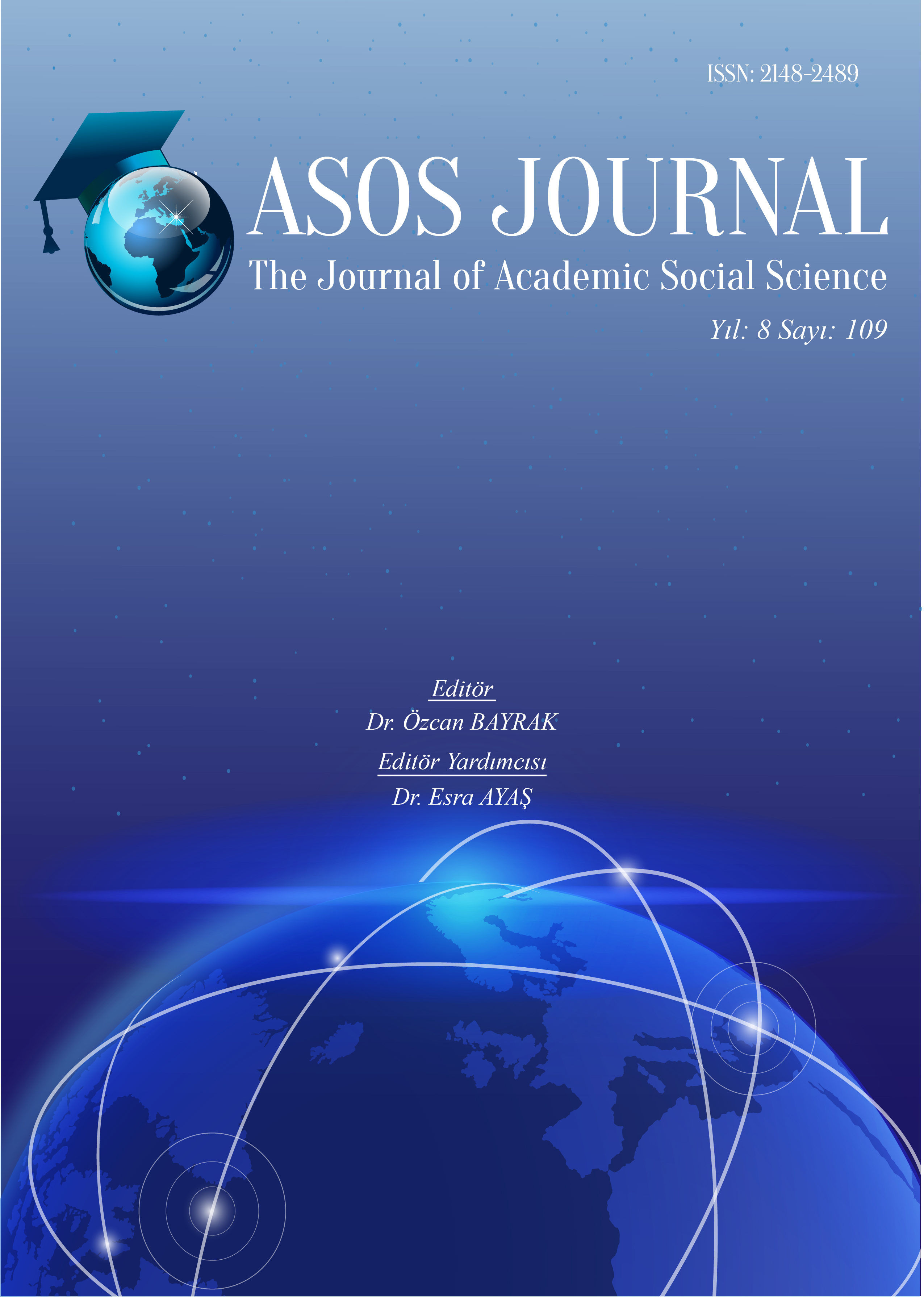AVRUPA BİRLİĞİNE 5. GENİŞLEME DÖNEMİNDE ÜYE OLAN ÜLKELERDE DIŞ TİCARETİN EKONOMİK BÜYÜMEYE ETKİSİ: PANEL VERİ ANALİZİ
Author :
Abstract
Dünya genelinde yaygınlaşan küreselleşme sürecinin etkisiyle dış ticaret ülkelerin ekonomik gelişmelerinin itici gücü durumuna gelmiştir. Avrupa Birliği de üye ülkeler arasında ticaret hacmini arttırarak birliğin genelinde refahı arttırmaya çalışan dinamik bir örgüt olarak ön plana çıkmaktadır. Bu çalışmada Avrupa Birliğine 5. Genişleme döneminde üye olan, çoğu post Sovyet olan ülkelerin birliğe dahil olduktan sonra gerçekleştirdikleri dış ticaretin ekonomik büyümelerine olan etkileri 2004-2018 dönemi için ithalat, ihracat ve kişi başı milli gelir verileri ile panel veri analizi yardımıyla araştırılmıştır. Sonuç olarak ithalattaki bir birimlik artışın kişi başına milli gelir değişkenini 0.0042 birim azaltacağı, ihracattaki bir birimlik artışın isekişi başına milli gelir değişkenini 0.0672 birim artıracağı belirlenmiştir. İthalatın kişi başı milli gelir üzerine negatif, ihracatın ise pozitif etkisi bulunmuştur. Dolayısıyla Avrupa Birliğine 5. Genişleme döneminde üye olan ülkeler için ihracat çekişli büyüme hipotezinin geçerli olduğu söylenebilir.
Keywords
Abstract
Foreign trade has become the driving force of the economic developments of countries due to the globalization process, which is spreading around the world.The European Union also stands out as a dynamic organisation that is trying to increase the volume of trade among members and increase prosperity across the union. In this study , impacts of foreign trade on economic growth in countries are mostly post-soviet and became members of european union during the 5th expansion period were analyzed in statistics of import, export , and national income data for the 2004-2018 years with the help of panel data analsis.As a result, it was determined that the increase in one unit in imports would reduce the national income variable per capita by 0.0042 units, while the increase in one unit in exports would increase the national income variable per capita by 0.0672 units. Imports have a negative effect on per capita income, while exports have a positive effect..Therefore, it can be said that the export-driven hypothesis is valid for the countries who became members of the european uniion during the 5th expansion period.
Keywords
- Adegboyega, R. R. (2017). TheImpact of Export and Import on Economic Growth in Nigeria: Evidence from VAR Approach. Journal of Management and Social Sciences, 6, 364349.
- Akcan, A. T.,& Metin, İ. (2018). Dış Ticaretin Ekonomik Büyüme Üzerindeki Etkisi: Türkiye Örneği. Electronic Turkish Studies, 13(14).
- Akhter, M. (2015). The impact of export and import on economic growth in Bangladesh. World Vision, 9(1), 66-81.
- Ayata A. (2016). “Avrupa Birliği Kurumsal Yapısı ve Karar Alma Mekanizması”, Avrupa Birliği ve Türkiye ile ilişkileri, Editörler: Ali Ayata & Murat Ercan, Nobel Akademik Yayıncılık Ankara, ss. 47-73.
- Aytaç, A. (2017). Ekonomik Büyüme–İhracat İlişkisi: 2001-2016 Türkiye Örneği. Sosyal Bilimler Araştırma Dergisi, 6(4), 214-222.
- Awokuse, T. O. (2007). Causalitybetweenexports, imports, and economic growth: Evidence from transition economies. Economics letters, 94(3), 389-395.
- Bakari, S., & Mabrouki, M. (2017). Impact of exportsandimports on economicgrowth: newevidencefrom Panama. Journal of Smart EconomicGrowth, 2(1), 67-79.
- Bakari, S., Fakraoui, N., &Tiba, S. (2019). Domestic Investment, Export, Import and Economic Growth in Brazil: An Application of Vector Error Correction Model. MPRA Paper No.
- Bakari, S. (2017). The Three-Way Linkages between Export, Import and Economic Growth: New Evidence fromTunisia. MPRA Paper No. 81080
- Breusch, T.S.,& Pagan, A.R. (1980). The Lagrange multiplier test and its applications to model specification in econometrics. The Review of Economic Studies, 239-253.
- El Alaoui, Aicha (2015): Causality and cointegration between export, import and economic growth: evidence fromMorocco. Published in: Journal of World Economic Research , Vol. 3, No. 4 (8 June 2015): pp. 83-91.
- Gujarati, D. N.,& Porter, D. C. (2003). Basic econometrics (ed.). New York: McGraw-HiII.
- Guntukula, R. (2018). Exports, imports and economic growth in India: Evidence from cointegration and causality analysis. Theoretical & Applied Economics, 25(2). 221-230.
- Hamdan, B. S. (2016). The effect of exports and imports on economic growth in the Arab countries: A panel data approach. Journal of Economics Bibliography, 3(1), 100-107.
- Korkmaz, S.,& Aydın, A. (2015). Türkiye’de dış ticaret-ekonomik büyüme ilişkisi: Nedensellik analizi. Eskişehir Osmangazi Üniversitesi İİBF Dergisi, 10(3), 47-76
- Mehta, S. N. (2015). The Dynamics of Relationship between Exports, Import and Economic Growth in India. International Journal of Research in Humanities and Social Sciences, 3(7), 39-49.
- Öztürk, E.,& Özel, H. A. (2018). E-7 Ülkelerinde Dış Ticaretin Ekonomik Büyümeye Etkisi. Journal of Süleyman Demirel University Institute of Social Sciences Year, 2(31), 358369.
- Pesaran, M.H. (2004). General diagnostic tests for crosssection dependence in panels.
- Pesaran, M.H. (2007). A simple panel unitroot test in the presence of cross‐sectiondependence. Journal of AppliedEconometrics, 22(2), 265-312.
- Pesaran, M.H.,Ullah, A., andYamagata, T. (2008). A bias‐adjusted LM test of errorcross‐sectionin dependence. The Econometrics Journal, 11(1), 105-127.
- Şerefli, M. (2016). Dış Ticaretin Ekonomik Büyüme Üzerine Etkisi: Türkiye Örneği. Kastamonu University Journal of Economics & Administrative Sciences Faculty, 13.
- Thirunavukkarasu, V.,& Achchuthan, S. (2014). Export, import and economic growth: Evidence from Sri Lanka. Journal of Economics and Sustainable Development, 4(9), 147-155.
- Uddin, G.,Khan, S., & Alam, M. (2010). An empirical study on export, import and economic growth in Bhutan. Indian Development Review (ISSN 0972-9437), 8(1), 95-104.
- Yenipazarlı, A.,& Erdal, F. (2010). Dış Ticaretin Serbestleşmesi Ve Ekonomik Büyüme. Ekonomi Bilimleri Dergisi, 2(1), 15-24.
- Yüksel, S.,& Zengin, S. (2016). Causality relation ship between import, export and growth rate in developing countries. International Journal of Commerce and Finance, 2(1), 147-156.
